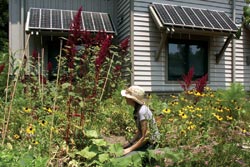The Marshall Senior Center serves nearly 300 meals a day and offers a variety of activities for Madison County's elderly population, but the facility needed an energy face-lift. Enter the green team, led by the Global Institute for Sustainability Technologies, a new A-B Tech program that tackles special projects and holds workshops on such topics as “green-collar” jobs and solar-electric systems.

The senior-center greening was GIST's first project. With a portion of the $354,000 federal appropriation that U.S. Rep. Heath Shuler helped secure last year for the school's Clean Energy Business Incubator, the institute pulled together a collaborative effort. The French Broad Electric Membership Corp. conducted a free audit to determine the center's energy needs and then donated compact-fluorescent light bulbs and faucet aerators. The Energy Team at Asheville Green Opportunities replaced the light bulbs, installed the aerators and caulked the center's windows and doors. (The nonprofit provides paid job training and placement to unemployed, out-of-school young adults, helping them obtain “green-collar” jobs that pay a living wage.) And First Light Solar, a Black Mountain-based business, helped fund a solar hot-water system.
GIST Coordinator Leslee Thornton says the project had three goals: demonstrating a working solar hot-water system in Madison County, reducing energy costs at the center and providing work-force training.
Community Services Director Penny Buckner, meanwhile, says the project teaches everyone a little something about sustainability: “My son graduated this year, and he preaches to me every day [that] we need to go green,” she notes, adding, “The seniors, they're learning.”
The Web zine GreenBiz recently highlighted Superintendent Ron Wilcox's efforts to boost energy efficiency in the 2,600-student Madison County Schools. More than a year ago, when the system's electric bills were running 38 percent higher than budgeted, Wilcox persuaded county officials to borrow $3.7 million for energy-efficiency improvements, and he partnered with the Appalachian Regional Commission to get three small windmills installed to generate electricity. Says Wilcox: “We're rural; we're small. But it's our goal to be the school system that leads the way with alternative energy.” To view the full article, visit www.greenbiz.com (click on the “resource efficiency” tab).
Platinum green
Warren Wilson College seems to grow greener by the minute. Last week, it was the Mountain Green Sustainability Conference; this news cycle, it's the EcoDorm. Opened in 2003 as a pioneering model of energy-efficient building design and renewable-energy technologies, the WWC residence hall recently became the first existing building on a U.S. college campus to achieve LEED Platinum certification in the existing buildings category. Platinum is the highest rating possible in LEED (Leadership in Energy and Environmental Design, a widely recognized rating system developed by the U.S. Green Building Council).
Designed by Samsel Architects of Asheville, the two-story structure houses 36 residents. Warren Wilson students helped plan, research and design the building, which initially had four green priorities: energy efficiency, water conservation, indoor air quality and use of local and recyclable materials. All wood used in the EcoDorm was either recycled or timber milled and finished on campus.
One of the more unusual features students came up with is a salvaged 10,000-gallon railroad tanker car; fed by roof runoff, the underground cistern provides water for flushing toilets and irrigating the dorm's permaculture landscaping. The building's energy-saving technologies include solar hot water, photovoltaic panels, high-efficiency boilers and radiant floor heating. A Web-based energy-monitoring system keeps tabs on it all.
Additionally, the N.C. Sustainable Energy Association used data provided by Warren Wilson's “greening crew” to prompt the N.C. General Assembly to enact a 2007 law promoting energy and water conservation in state-owned buildings, including universities and community colleges.
“LEED provides an excellent guideline and methods for putting ‘money where your mouth is' related to sustainable maintenance,” says Paul Braese, director of facilities management and technical services at Warren Wilson. “It offers a way to measure, and therefore manage, sustainability via maintenance operations.”
He continues, “Specifically because of the [EcoDorm project], Warren Wilson has begun the implementation of sustainability across the campus in the areas of integrated pest management, storm-water control, green housekeeping – procedures, purchases and equipment – low VOC [volatile organic compound] paints and glues, indoor air quality and the use of alternative materials.”
Other LEED-certified buildings at the college include Orr Cottage and the Village South and Village North residences. Orr Cottage, completed in 2005, was the first LEED Gold building on a college campus in North Carolina. The Village dorms, which opened a year later, have since achieved LEED Gold for new construction.
Send your environmental news to mvwilliams@mountainx.com or call 251-1333, ext. 152.



“What’s Inside the Nation’s Greenest Dorm? Happy Students”
by Lauren Hasler
A college student’s desire to lead an eco-friendly lifestyle is often hindered by lack of opportunity in dormitories or residence halls. Limited access to recycling, composting and energy controls often make it difficult to keep on the green path….
http://earth911.com/blog/2009/10/16/whats-inside-the-nations-greenest-dorm-happy-students/